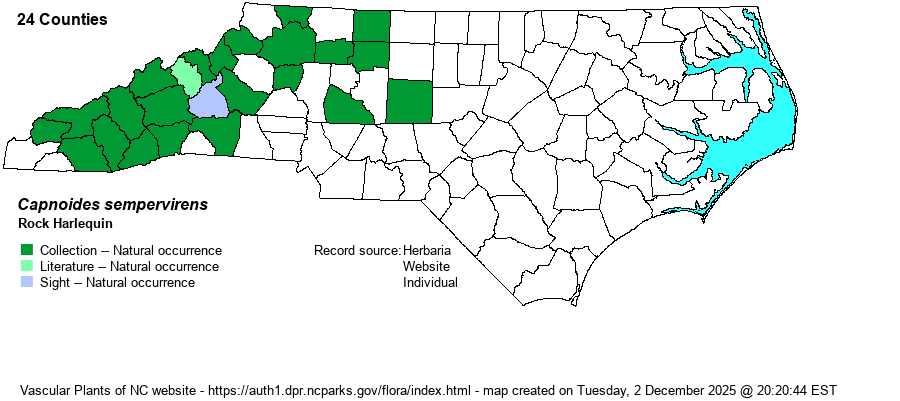| Section 6 » Family Fumariaceae |
Show/Hide Synonym
| taxonName | relationship | relatedTaxonName | relatedTaxonRefText | relComments |
|---|
|
|
|
| Capnoides sempervirens | = | Corydalis sempervirens | Gleason and Cronquist (1991) | | | Capnoides sempervirens | = | Corydalis sempervirens | Fernald (1950) | | | Capnoides sempervirens | = | Corydalis sempervirens | Flora of North America (1993b, 1997, 2000, 2002a, 2002b, 2003a, 2004b, 2005, 2006a, 2006b, 2006c, 2007a, 2009, 2010) | | | Capnoides sempervirens | = | Corydalis sempervirens | Gleason (1952) | | | Capnoides sempervirens | = | Corydalis sempervirens | | | | Capnoides sempervirens | = | Corydalis sempervirens | | | | Capnoides sempervirens | = | Corydalis sempervirens | Radford, Ahles, and Bell (1968) | | | Capnoides sempervirens | = | Corydalis sempervirens | | | | Capnoides sempervirens | = | Corydalis sempervirens | Wofford (1989) | | | Capnoides sempervirens | = | Corydalis sempervirens | Flora of West Virginia | | | Capnoides sempervirens | = | Corydalis sempervirens | Lidén in Kubitzki, Rohwer, & Bittrich (1993). | | | Source: Weakley's Flora |
|
| Author | (L.) Borkhausen | |
| Distribution | Present throughout the Mountains, sparingly east to the central Piedmont; ranges east to Stokes and Randolph counties.
This is a Northern species, ranging from central and eastern Canada, south to PA and northern IL, and southward in the Appalachians to northern GA. | |
| Abundance | Uncommon to infrequent in the Mountains, but rare to locally uncommon in Piedmont foothills. Very rare in the central Piedmont. | |
| Habitat | This is a rock-obligate species. It grows best on granitic domes, but also is found on other exposed rocky crags, crevices, cliffs, and rocky bluffs. All or nearly all sites are on acidic soils and felsic rocks, such as on granite. | |
| Phenology | Blooms from April to June, and fruits shortly after flowering. | |
| Identification | This is a unique species, especially as it has been removed from the genus Corydalis to now Capnoides, where it is the only species. It is conspicuously glaucous (pale whitish-green), growing to about 1-1.5 feet high, with several divaricate branches in the upper portions. The leaves are bi-pinnately divided, with the ultimate leaf segments somewhat finger-like, with entire margins. The flowers grow in slender panicles at the ends of branches, with a handful of beautiful rosy-pink flowers with yellow lips, and a bulbous spur on the back of the floral tube. Each flower is 3/4-inch long, as well. This is a striking wildflower, especially as there are usually very few showy wildflowers in bloom in its rocky habitats. Even when in leaf only, the very pale glaucous color of the plant, plus the divided leaves, should be obvious. | |
| Taxonomic Comments | Generally named as Corydalis sempervirens through most of the last century.
| |
| Other Common Name(s) | Pink Corydalis, Pale Corydalis, Tall Corydalis, Harlequin Corydalis | |
| State Rank | S3 | |
| Global Rank | G5 | |
| State Status | | |
| US Status | | |
| USACE-agcp | | |
| USACE-emp | | |

